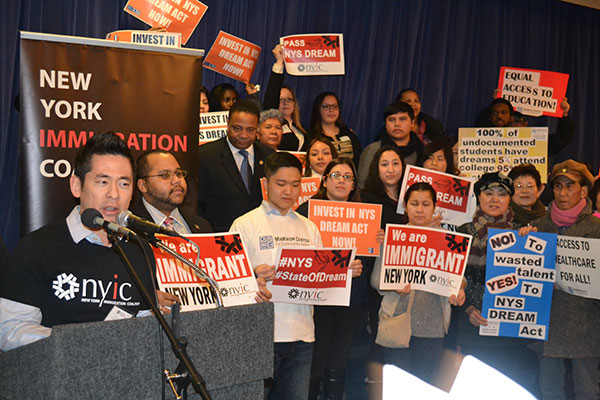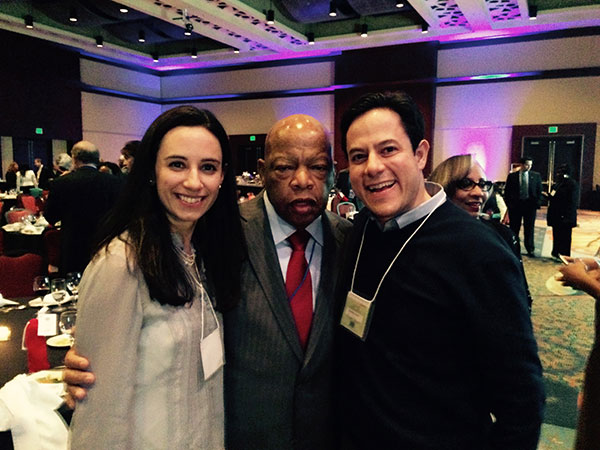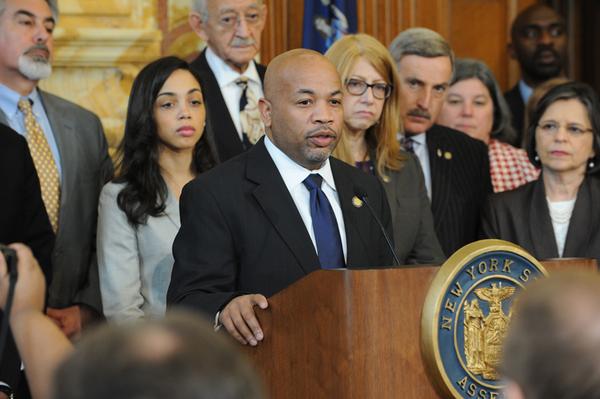Separating Fact from Fiction on the DREAM Act

The author at a rally for the DREAM Act
The gridlocked Congress' failure to produce needed, overdue immigration reform prompted several states to create their own versions of the proposed federal DREAM Act, which would provide publicly financed college tuition aid to undocumented immigrants.
Texas, a red state; California, a blue state; and New Mexico, a purple state; each has adopted its own version of the DREAM Act.
In New York, the DREAM Act enjoys the support of editorial boards as varied in their opinions, politics, and geographical concerns as Newsday, the New York Post, Rochester Democrat and Chronicle, the New York Times, the Albany Times Union, and the New York Daily News.
So why did the New York DREAM Act go down in defeat—narrowly—in the Legislature last year? Mostly because of fear and anger stirred up by opponents through the spread of misinformation.
If New York is to enact the DREAM Act this year and make the commonsense investment in its workforce and future that editorial boards, elected officials, and New Yorkers across the state are calling for, we need to separate the fact from the fiction.
Fiction: The DREAM Act will take money away from students who were born in this country and give it to those who were not.
Fact: New York's Tuition Assistance Program (TAP) is an entitlement program. Each and every student who meets the TAP income eligibility and other requirements is entitled to financial aid—no matter what. The additional cost of providing TAP dollars to Dreamers is estimated to range between $17 million and $27 million, about a .00018% increase in the state budget.
Fiction: The DREAM Act will reward people who broke the law.
Fact: Punishing young people for something their parents did is not the American way. And let's not lose sight of the fact that what the parents of Dreamers are guilty of is wanting a better life for their children, like generations before them and generations to come.
Fiction: The DREAM Act doles out tax dollars to people who themselves don't pay taxes.
Fact: According to a study by the Institute on Taxation and Economic Policy, undocumented immigrants contributed an estimated $744,276,000 New York State taxes in 2010. At the federal level, the Social Security Administration each year keeps $6 billion to $7 billion in social security contributions from W-2s that cannot be matched with a correct social security number. The vast majority of that money comes from undocumented immigrants who are forbidden by law to access many of the most basic government services which they help fund.
And the Fiscal Policy Institute has calculated that bachelor's degree holders pay an additional $3,900 in annual state taxes, meaning that TAP funding for the undocumented would more than pay for itself within six years.
In other words, making college more affordable for all is a smart investment in workforce development and our state's future. The more educated our workforce, the better it is for our economy - and Dreamers will most certainly be part of our workforce. They don't know any country other than the United States. Their futures are here.
Let's follow the bipartisan example of the five states that have already passed a DREAM Act. Let's come together in New York and make the DREAM Act a reality.
***
by Steven Choi is Executive Director of New York Immigration Coalition (on Twitter @stevechoinyic & @thenyic).
***
Have an op-ed idea or submission for Gotham Gazette? E-mail editor Ben Max: This email address is being protected from spambots. You need JavaScript enabled to view it.
Our Time in Selma

Council Member Dan Garodnick, in Selma
Last weekend, my wife Zoe and I had the privilege of going to Alabama to trace some steps of the foot soldiers of the Civil Rights Movement as part of the jubilee celebration of the 1965 march from Selma to Montgomery. We were honored to pay respect to those who gave so much of themselves in pursuit of justice and who changed American history in the process. We immersed ourselves in that history as part of a group organized by the Faith and Politics Institute, and came away with an even deeper resolve to further their work.
We sat in the 16th Street Baptist Church in Birmingham, where a bomb exploded over 50 years ago, tragically stealing the lives of four young black girls, their futures taken from them while they were changing into their choir robes.
We visited Brown Chapel A.M.E. Church in Selma, where ordinary Americans gathered to learn the tactics of nonviolence, and steeled themselves for the unknown as they endeavored to march 55 miles to Montgomery to deliver a clear message to the Alabama Governor, and ultimately to the world.
And we went to the Edmund Pettus Bridge, the site of Bloody Sunday -- where so many of them were brutally attacked by an angry mob of police -- precisely a half-century ago.
We heard Congressman John Lewis, leader of the first march in Selma, describe being beaten unconscious on that bridge as he and his compatriots attempted to march quietly, two-by-two in support of their fundamental rights.
He wasn't doing it to be a hero. He was doing it because of a deeply held belief in the equality of man, and with his faith that God would protect him from harm. Indeed, while he might have anticipated a night in jail - and had stocked his backpack with an apple, toothbrush and book for that eventuality - he didn't actually expect the march to result in violence, which it did, at the hands of billy clubs, horse hooves, and tear gas. He does not remember how he got off the bridge.
We admired his bravery in moving forward, as the police in Selma had put out a call to a mob of young white men to serve as "deputies" to help them stop this march from proceeding.
We heard him tell the story about the man who visited his congressional office in 2009, who had assaulted him years earlier, and asked for his forgiveness. Without an ounce of bitterness or regret, John Lewis forgave him and "called him my brother."

Council Member Garodnick with his wife, Zoe, and Rep. John Lewis
Among other giants from the movement, we spent time with Juanita Abernathy, the widow of Ralph Abernathy, who never missed a march.
We heard from the daughter of Viola Liuzzo, a mother of five from Detroit who heeded Dr. Martin Luther King's call to come to Selma, and who was murdered when her car was run off the road by the Ku Klux Klan. When asked why her mother went to Selma, she responded: "The real question is: Why didn't everyone go to Selma?"
And of course, we were moved to see John Lewis and President Barack Obama embrace at the foot of the Edmund Pettus Bridge. The president, whose very presence next to that bridge spoke volumes, captured the spirit of America when he referred to the courage of the foot soldiers, and asked: "What could be more American than what happened in this place?" He added: "We were born of change."
The most important takeaway for me: while times have changed significantly, the work of Selma is not complete. There is so much more to do.
On police-community relations, an issue that animated much of this past year, President Obama reminded us that the citizens of Ferguson, New York, and Cleveland "just want the same thing young people here marched for – the protection of the law." At the same time, he cautioned against marginalizing our police, as they are "members of the very communities they risk their lives to protect." This conversation will appropriately continue in New York, and all across this country, and in the tradition of Dr. King, we must do so with peace and civility in our hearts.
Significantly, our voting rights themselves are under attack. The Supreme Court recently struck down key portions of the Voting Rights Act, which gave the federal government the chance to "pre-clear" voting rules in areas with historic discrimination. At the same time, states have been enacting laws designed to make it even tougher for people to vote. All of this in a country that already has among the lowest voting rates among free nations. Those facts are beyond disappointing; they are actually disrespectful to those who gave so much to solidify basic rights for all Americans.
Unfortunately, Congress has not yet acted to fix what the Court has done.
The Voting Rights Act was, as President Obama said, a "crowning achievement of our democracy" and it is now "subject to partisan rancor." That cannot be. Re-activating key portions of the Voting Rights Act is the right way to honor those brave men and women who marched in 1965, and Congress should act without delay. If you agree, you can add your voice here.
And of course, right here in New York, we need to lead on ballot access issues. We should take steps to allow for early voting and same-day registration, as well as no-excuse absentee voting and instant runoffs - all ways to make it easier for people to participate in the electoral process. But that alone won't solve our voting issues. People still need to see a reason to come out and cast a ballot. In our last statewide election in New York, a pathetic 28.8 percent of eligible voters turned out to the polls. Scandal, negative campaigning, and general frustration are contributing factors – and we need to turn the ship around.
The visit to Alabama was inspiring and humbling at the same time. We must honor the foot soldiers of the Civil Rights Movement by giving people a reason to participate, and by defending and strengthening the rights that they fought so hard to achieve.
***
Dan Garodnick is a member of the New York City Council, representing the fourth district, in Manhattan.
***
Have an op-ed idea or submission for Gotham Gazette? E-mail editor Ben Max: This email address is being protected from spambots. You need JavaScript enabled to view it.
Dear Speaker Heastie: Support for your DREAM Act push is strong

Speaker Heastie (photo: Lori Van Buren)
Dear Speaker Carl Heastie:
A few weeks ago, you shared your initial priorities as the new Assembly Speaker. It was refreshing to see you focus on expanding access to opportunity for all of New York's youth, including the thousands of undocumented students who deserve a fair chance at going to college. We, the College Access Consortium of New York (CACNY), a network of over 100 professionals representing community-based organizations, colleges, and secondary schools, stand by you in fighting for the NY DREAM Act this session.
The American Dream is based upon the principle of equal opportunity for all. However, making that dream a reality for thousands of first generation college students cannot wait another year. According to USA Today, of the more than five million first generation low-income students, only 11 percent will earn a college degree.
In May of 2011 the NY DREAM Act was introduced to level the playing field for the children of undocumented immigrants. This idea builds upon bipartisan legislation passed over a decade ago by Governor Pataki that granted in-state tuition rates to undocumented youth. At its core, the NY DREAM Act is key for thousands of youth across the state to obtain post-secondary opportunities by allowing them access to state financial aid, just like any other student proudly walking across the stage at their high school graduation or dancing at their senior prom.
As college access and success professionals, members of the CACNY community know that unequal access to the Tuition Assistance Program and other forms of state aid can be the proverbial 'straw that breaks the camel's back,' preventing an otherwise willing and capable student from accessing and succeeding in college and subsequently contributing to the workforce of our state.
As a fellow New York City native, I have seen first-hand the negative educational and economic impact that delaying the NY DREAM Act for four years has had on our communities. In solidarity with our fellow CACNY members, we express our collective support and desire that your efforts this year will yield a different outcome.
***
by Felipe Ayala Jr., Chair of the College Access Consortium of New York
***
Have an op-ed idea or submission for Gotham Gazette? E-mail editor Ben Max: This email address is being protected from spambots. You need JavaScript enabled to view it.




